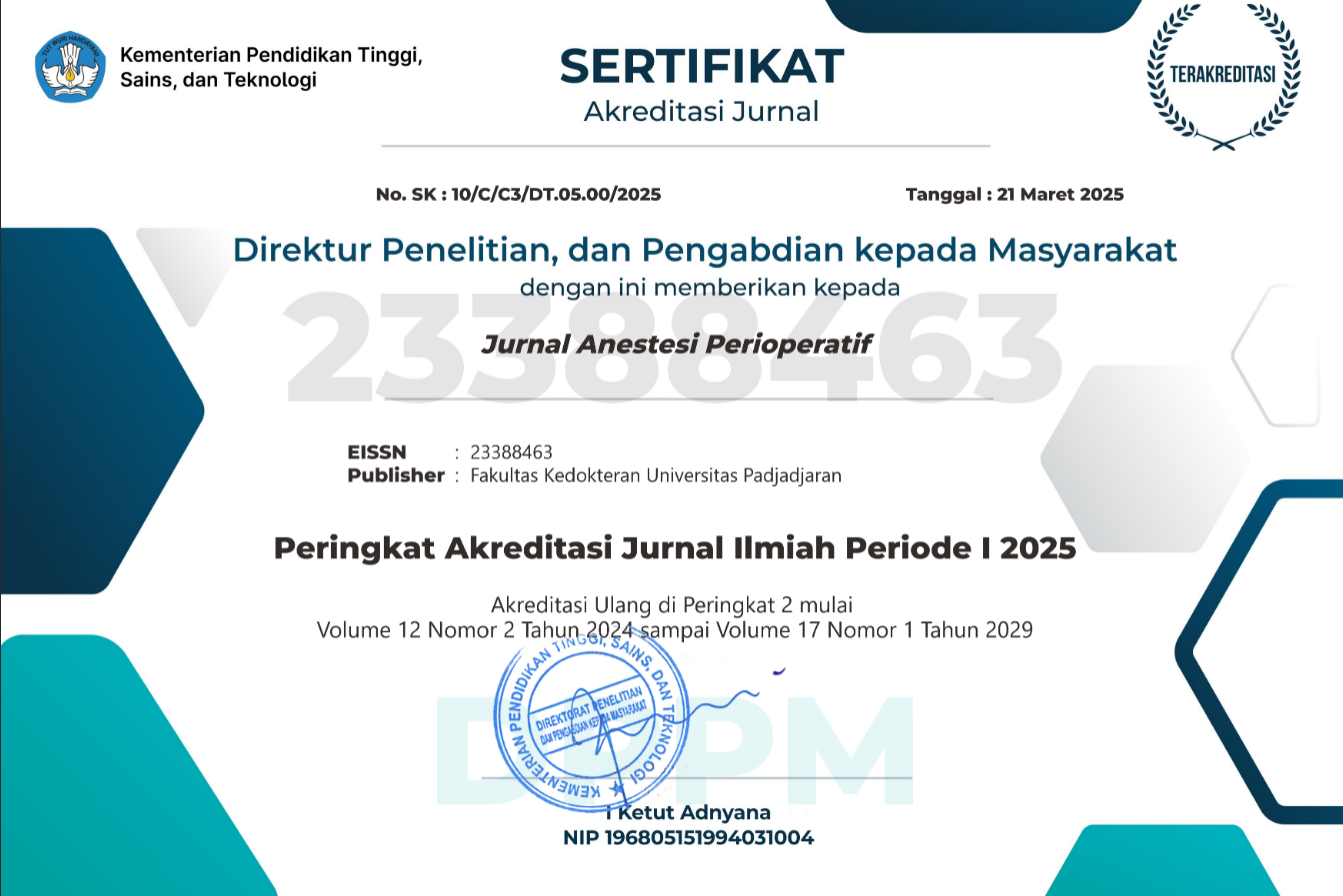Efek Ondansetron Intravena terhadap Tekanan Darah dan Laju Nadi pada Anestesi Spinal untuk Seksio Sesarea
Abstract
Hipotensi merupakan komplikasi anestesi spinal yang sering ditemukan pada seksio sesarea. Pencegahan hipotensi dapat dilakukan dengan pemberian cairan, vasopresor, dan memperbaiki posisi uterus ibu saat terlentang dengan mengganjal punggung. Penelitian ini bertujuan mengetahui pengaruh ondansetron 8 mg yang diberikan 5 menit sebelum spinal anestesi dalam menjaga kestabilan hemodinamik. Penelitian ini dilakukan di Rumah Sakit Dr. Hasan Sadikin Bandung pada Januari–Maret 2014 dengan desain eksperimental secara acak klinis terkontrol tersamar ganda yang mengikutsertakan 46 ibu hamil dengan status fisik American Society of Anesthesiologist (ASA) I−II yang menjalani seksio sesarea menggunakan anestesi spinal. Setelah randomisasi secara blok permutasi, subjek penelitian dikelompokkan menjadi 2, yaitu 23 subjek kelompok kontrol mendapat NaCl 0,9% dan 23 subjek kelompok perlakuan mendapat ondansetron intravena 8 mg. Tekanan darah dan laju nadi diperiksa setiap 1–15 menit setelah anestesia spinal, kemudian diperiksa tiap 3 menit sampai operasi selesai. Data hasil penelitian dianalisis dengan uji-t, Uji Mann-Whitney, dan Uji Kolmogorov-Smirnov. Analisis statistik menunjukkan perbedaan bermakna tekanan darah sistol, tekanan darah rata-rata, dan jumlah pemakaian efedrin antara kelompok kontrol dan kelompok ondansetron (p<0,05). Simpulan, pemberian ondansetron 8 mg dapat mengurangi hipotensi dan menurunkan jumlah pemberian efedrin pasca-anestesi spinal pada operasi seksio sesarea.
Kata kunci: Anestesi spinal, hipotensi, ondansetron, seksio sesarea
Intravenous Ondansetron Effect on Blood Pressure and Heart Rate in Caesarean Section under Spinal Anesthesia
Hypotension is the most common complication in spinal anesthesia during cesarean sections. One of the prevention efforts includes administering a fluid vasopressor or placing a wedge under the right hip for left uterine displacement. This study aimed to determine the effect of ondansetron 8 mg, 5 minutes before spinal anesthesia, to maintain maternal hemodynamic stability. This double-blind randomized control experimental study was conducted in Dr. Hasan Sadikin General Hospital Bandung during the period of January to March 2014 on 46 pregnant women, American Society of Anesthesiologist (ASA) II, who underwent cesarean section with spinal anesthesia. After randomization, the subjects were grouped into two groups: 23 subjects were included in the control group receiving Nacl 0.9% and 23 subjects were included in the ondansetron group receiving 8 mg of ondansetro. Blood pressure and pulse rate were examined every minute until 15 minutes after spinal anesthesia and then every 3 minutes until the operation was complete. Data were analyzed statistically using t test, Mann Whitney Test, and Kolmogorov-Smirnov Test. The results show that there were significant differences in systol presure, average blood pressure, and use of ephedrine between the control and ondansetron group (p<0.05). In conclusion, the provision of 8 mg ondansetron can prevent hypotension and reduce ephedrine use after spinal anesthesia in caesarean section.
Key words: Spinal anesthesia, caesarean section, hypotension, ondansetron, sectio sesareaspinal anesthesia
Keywords
Full Text:
PDFArticle Metrics
Abstract view : 3552 timesPDF - 5070 times
This Journal indexed by

JAP is licensed under a Creative Commons Attribution-NonCommercial 4.0 International License
View My Stats



